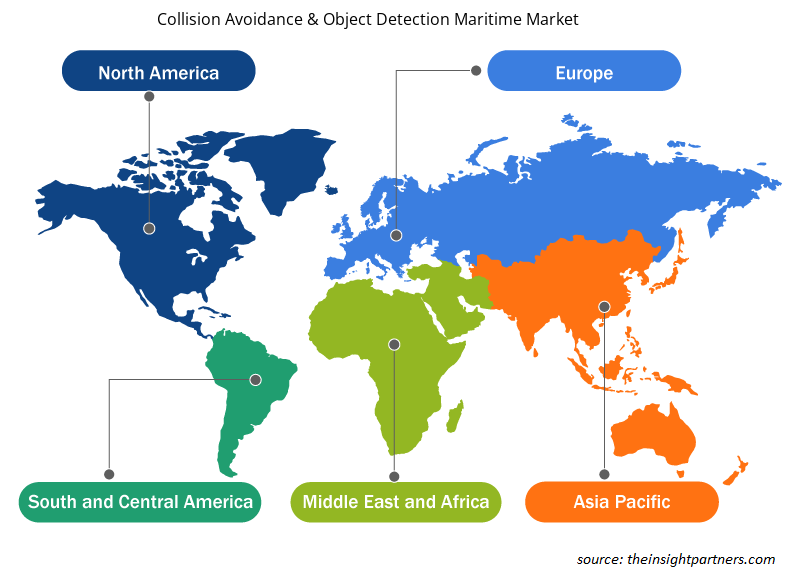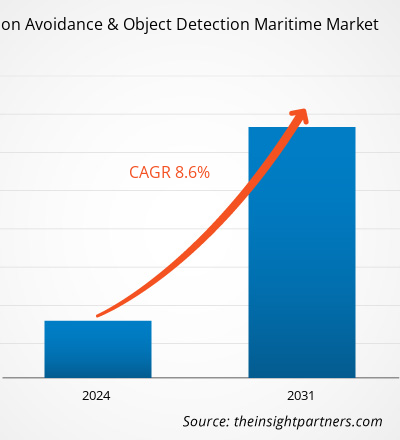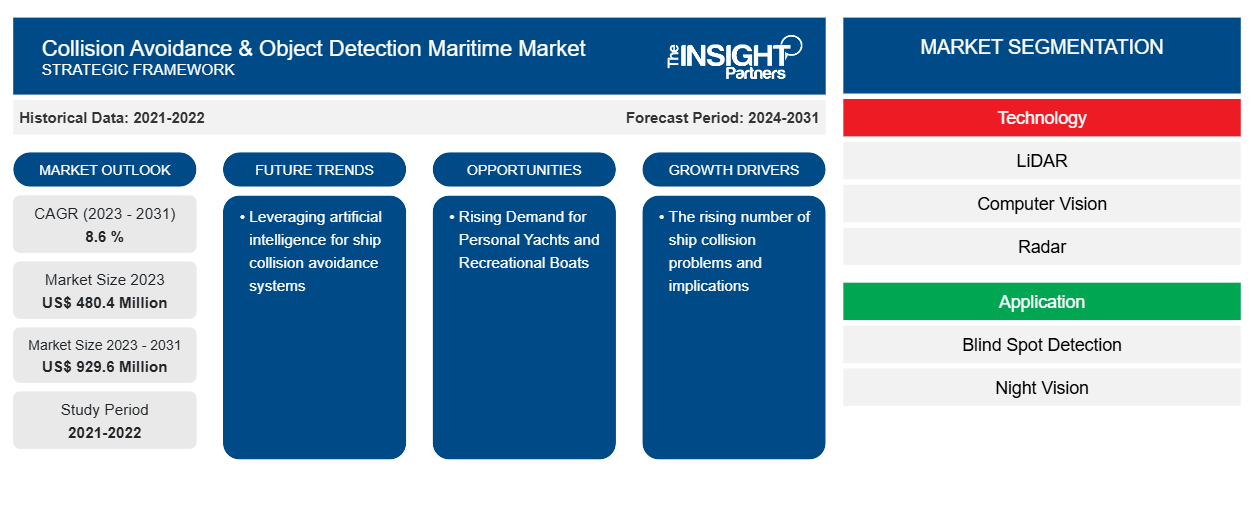Der Markt für Kollisionsvermeidung und Objekterkennung im Seeverkehr soll von 480,4 Millionen US-Dollar im Jahr 2023 auf 929,6 Millionen US-Dollar im Jahr 2031 anwachsen. Der Markt wird zwischen 2023 und 2031 voraussichtlich eine durchschnittliche jährliche Wachstumsrate von 8,6 % verzeichnen. Der Einsatz künstlicher Intelligenz für Schiffskollisionsvermeidungssysteme dürfte ein wichtiger Trend auf dem Markt bleiben.CAGR of 8.6 % during 2023–2031. Leveraging artificial intelligence for ship collision avoidance systems is likely to remain a key trend in the market.
Kollisionsvermeidung und Objekterkennung – Maritime Marktanalyse
Kollisionsvermeidungssysteme im Seeverkehr verlassen sich auf etablierte Navigationshilfen und -standards, um Schiffskollisionen zu vermeiden und als Grundlage für die Sicherheit auf See zu dienen. Radar, ECDIS, ARPA, VTS sowie Navigationslichter und -signale sind schon seit geraumer Zeit im Einsatz. Sie haben sich im langjährigen Einsatz unter unterschiedlichen maritimen Bedingungen als zuverlässig erwiesen. Zu den auffälligeren Merkmalen dieser Schiffskollisionsvermeidungssysteme gehören Reichweiten- und Peilungsinformationen, vernetzte Funktionen, Alarm- und Warnsysteme und mehr.ECDIS, ARPA, VTS, and navigational lights and shapes have all been in use for quite some time. They have proven themselves reliable over many years of actual use in a variety of maritime conditions. Some of the more noticeable features of these vessel collision avoidance systems include range and bearing information, interconnected functionality, alarm and warning systems, and others.
Kollisionsvermeidung und Objekterkennung – Überblick über den maritimen Markt
Schiffsunglücke bleiben ein kritisches Problem in der Schifffahrtsindustrie und bergen ernsthafte Risiken für Schiffe, die Umwelt und die Sicherheit von Menschen. Das enorme Wachstum des weltweiten Schiffsverkehrs und die zunehmende Überlastung wichtiger Wasserstraßen haben die Wahrscheinlichkeit dieser Unfälle erhöht. Um diese Gefahren zu mindern, haben sich künstliche Intelligenz (KI) und computergestützte Schiffskollisionsvermeidungssysteme (VCAS) als wichtige Techniken zur Hindernisvermeidung herausgestellt. Diese Systeme nutzen rund um die Uhr Computervision und Sensorfusion, um Gefahren in Echtzeit zu analysieren und leisten so einen wesentlichen Beitrag zur Sicherheit auf See.VCAS) have emerged as critical obstacle avoidance techniques. These systems use 24/7
Passen Sie diesen Bericht Ihren Anforderungen an
Sie erhalten kostenlose Anpassungen an jedem Bericht, einschließlich Teilen dieses Berichts oder einer Analyse auf Länderebene, eines Excel-Datenpakets sowie tolle Angebote und Rabatte für Start-ups und Universitäten.
-
Holen Sie sich die wichtigsten Markttrends aus diesem Bericht.Dieses KOSTENLOSE Beispiel umfasst eine Datenanalyse von Markttrends bis hin zu Schätzungen und Prognosen.
Kollisionsvermeidung und Objekterkennung – Treiber und Chancen auf dem maritimen Markt
Steigende Zahl von Schiffskollisionsproblemen und Auswirkungen auf den Markt
Schiffsunfälle bleiben ein großes Problem in der Schifffahrtsindustrie mit weitreichenden Folgen. Der Jahresüberblick der Europäischen Agentur für die Sicherheit des Seeverkehrs über Unfälle und Vorfälle auf See im Jahr 2023 berichtet, dass sich jedes Jahr etwa 4.000 sicherheitsrelevante Vorfälle ereignen. Diese Zahl deutet zwar auf einen Rückgang der Ereignisse im Vergleich zu den Vorjahren hin, unterstreicht aber auch die Beständigkeit des Problems. Diese Kollisionen kosten die Schifffahrtsindustrie jedes Jahr schätzungsweise 20 Milliarden US-Dollar an Schäden, längeren Ausfallzeiten für Reparaturen, Umweltschäden, Lieferkettenunterbrechungen, Gesundheits- und Sicherheitsvorfällen der Besatzung sowie Vertrauensverlusten bei Unternehmensinteressenten mit einem starken Interesse an Seeleuten. Schiffsunfälle werden durch eine Vielzahl von Umständen verursacht, darunter menschliche Fehler, Maschinenausfälle und schlechte Wetterbedingungen. Zahlreiche Forschungsarbeiten unterstützen menschliches Versagen als Hauptursache für Unfälle auf See. Zwischen 2014 und 2022 ergaben Sicherheitsuntersuchungen, dass 59,1 % der Unfallvorfälle durch menschliches Handeln verursacht wurden, wobei 50,1 % der beitragenden Variablen auf menschliches Verhalten zurückzuführen waren. Wenn sowohl menschliche Handlungen als auch menschliches Verhalten berücksichtigt wurden, war der menschliche Faktor für unglaubliche 80,7 % der untersuchten Unfälle und Vorfälle auf See in diesem Zeitraum verantwortlich. Überheblichkeit, Rücksichtslosigkeit als Reaktion auf kommerziellen Druck, Müdigkeit sowie ein Mangel an erforderlicher Sachkenntnis und Kommunikation wurden als Hauptursachen für die ordnungsgemäße Vermeidung von Barrieren identifiziert. Um Kollisionen zwischen Schiffen zu vermeiden, verlassen sich maritime Systeme auf etablierte Navigationshilfen und -standards, um Schiffskollisionen zu verhindern und die Grundlage für die Sicherheit auf See zu schaffen.
Steigende Nachfrage nach Privatyachten und Sportbooten
Yachten, die traditionell mit Luxus und Genuss assoziiert werden, werden als Anlagevehikel immer beliebter. Abgesehen von dem Luxus, den sie darstellen, bieten Yachten eine einzigartige finanzielle Möglichkeit, die über den Horizont hinausreicht. Die Investition in eine Yacht geht über die traditionelle Definition von Finanzanlagen hinaus. Es ist eine Investition in einen Lebensstil, Status und die Möglichkeit, finanziellen Gewinn zu erzielen. Mit der richtigen Technik können Yachten eine Mischung aus Vergnügen und Gewinn bieten, was sie zu einer attraktiven Option für Personen macht, die die Meere der Finanzen mit Flair und Raffinesse befahren möchten. Darüber hinaus sind Freizeitboote eine beliebte Alternative für alle, die ruhige Stunden auf dem Wasser verbringen möchten. Diese Boote sind Schiffe, die aktiv selbstfahrend navigieren können und hauptsächlich für Freizeit-, Angel- oder gewerbliche Zwecke verwendet werden. Aus diesem Grund steigt die Nachfrage nach Privatyachten und Freizeitbooten; die wachsende Zahl dieser Boote schafft also Nachfrage nach dem Wachstum des maritimen Marktes für Kollisionsvermeidung und Objekterkennung.yachters and recreational boats is increasing; thus, the growing number of these boats is creating demand for the growth of the collision avoidance & object detection maritime market.
Segmentierungsanalyse des maritimen Marktberichts zur Kollisionsvermeidung und Objekterkennung
Schlüsselsegmente, die zur Ableitung der Analyse des maritimen Marktes für Kollisionsvermeidung und Objekterkennung beigetragen haben, sind Technologie, Anwendung, Einsatzgebiet und Sektor.
- Basierend auf der Technologie ist der maritime Markt für Kollisionsvermeidung und Objekterkennung in LiDAR, Computer Vision, Radar und andere segmentiert.LiDAR, computer vision, radar, and others.
- Basierend auf der Anwendung ist der maritime Markt für Kollisionsvermeidung und Objekterkennung in die Bereiche Toter-Winkel-Erkennung, Nachtsicht und Sonstiges unterteilt.
- Basierend auf dem Endbenutzer ist der maritime Markt für Kollisionsvermeidung und Objekterkennung in unbemannte Oberflächenfahrzeuge, Schiffe und autonome Unterwasserfahrzeuge segmentiert.
Kollisionsvermeidung und Objekterkennung im maritimen Bereich – Marktanteilsanalyse nach Geografie
Der geografische Umfang des Berichts zum maritimen Markt für Kollisionsvermeidung und Objekterkennung ist hauptsächlich in fünf Regionen unterteilt: Nordamerika, Asien-Pazifik, Europa, Naher Osten und Afrika sowie Süd- und Mittelamerika. Die Exporte im asiatisch-pazifischen Raum werden voraussichtlich schnell steigen, unterstützt durch die anhaltend starke Entwicklung des intraregionalen Handels innerhalb des asiatisch-pazifischen Raums, da China, Indien und ASEAN weiterhin zu den am schnellsten wachsenden Schwellenmärkten der Welt gehören. Das maritime Singapur ist die Heimat von fast 5.000 maritimen Einrichtungen und 140 der weltweit führenden internationalen Schifffahrtsunternehmen, darunter Schiffsmanagement, Agenturen, Finanzen, Versicherungen, Makler und Vermessungsunternehmen. Die Branche unterstützt 160.000 Menschen. Die Präsenz solcher internationalen Schifffahrtsunternehmen und Exportziele schafft also eine Chance für das Wachstum des maritimen Marktes für Kollisionsvermeidung und Objekterkennung.intra-regional commerce within Asia Pacific, as China, India, and ASEAN remain among the world's fastest-growing emerging markets. Maritime Singapore is home to almost 5,000 maritime establishments and 140 of the world's leading international shipping firms, including ship management, agency, finance, insurance, broking, and surveying. The industry supports 160,000 people. Thus, the presence of such international shipping firms and export destinations creates an opportunity for the growth of the collision avoidance & object detection maritime market.
Kollisionsvermeidung & Objekterkennung Maritim
Regionale Einblicke in den maritimen Markt für Kollisionsvermeidung und Objekterkennung
Die regionalen Trends und Faktoren, die den Markt für Kollisionsvermeidung und Objekterkennung im maritimen Bereich während des gesamten Prognosezeitraums beeinflussen, wurden von den Analysten von Insight Partners ausführlich erläutert. In diesem Abschnitt werden auch die Marktsegmente und die Geografie für Kollisionsvermeidung und Objekterkennung im maritimen Bereich in Nordamerika, Europa, im asiatisch-pazifischen Raum, im Nahen Osten und Afrika sowie in Süd- und Mittelamerika erörtert.

- Erhalten Sie regionale Daten zum maritimen Markt für Kollisionsvermeidung und Objekterkennung
Umfang des Marktberichts zur Kollisionsvermeidung und Objekterkennung im Seeverkehr
| Berichtsattribut | Details |
|---|---|
| Marktgröße im Jahr 2023 | 480,4 Millionen US-Dollar |
| Marktgröße bis 2031 | 929,6 Millionen US-Dollar |
| Globale CAGR (2023 - 2031) | 8,6 % |
| Historische Daten | 2021-2022 |
| Prognosezeitraum | 2024–2031 |
| Abgedeckte Segmente |
Nach Technologie
|
| Abgedeckte Regionen und Länder |
Nordamerika
|
| Marktführer und wichtige Unternehmensprofile |
|
Dichte der Akteure auf dem maritimen Markt für Kollisionsvermeidung und Objekterkennung: Die Auswirkungen auf die Geschäftsdynamik verstehen
Der Markt für Kollisionsvermeidung und Objekterkennung im maritimen Bereich wächst rasant. Dies wird durch die steigende Nachfrage der Endnutzer aufgrund von Faktoren wie sich entwickelnden Verbraucherpräferenzen, technologischen Fortschritten und einem größeren Bewusstsein für die Vorteile des Produkts vorangetrieben. Mit der steigenden Nachfrage erweitern Unternehmen ihr Angebot, entwickeln Innovationen, um die Bedürfnisse der Verbraucher zu erfüllen, und nutzen neue Trends, was das Marktwachstum weiter ankurbelt.
Die Marktteilnehmerdichte bezieht sich auf die Verteilung der Firmen oder Unternehmen, die in einem bestimmten Markt oder einer bestimmten Branche tätig sind. Sie gibt an, wie viele Wettbewerber (Marktteilnehmer) in einem bestimmten Marktraum im Verhältnis zu seiner Größe oder seinem gesamten Marktwert präsent sind.
Die wichtigsten Unternehmen auf dem maritimen Markt für Kollisionsvermeidung und Objekterkennung sind:
- Benewake (Beijing) Co Ltd
- Orlaco Products BV
- Raytheon Anschutz GmbH
- Garmin Ltd
- Sea Machines Robotics Inc
- Robopec SAS
Haftungsausschluss : Die oben aufgeführten Unternehmen sind nicht in einer bestimmten Reihenfolge aufgeführt.

- Überblick über die wichtigsten Akteure auf dem maritimen Markt für Kollisionsvermeidung und Objekterkennung
Kollisionsvermeidung und Objekterkennung – Neuigkeiten und aktuelle Entwicklungen auf dem maritimen Markt
Der maritime Markt für Kollisionsvermeidung und Objekterkennung wird durch die Erfassung qualitativer und quantitativer Daten nach Primär- und Sekundärforschung bewertet, die wichtige Unternehmensveröffentlichungen, Verbandsdaten und Datenbanken umfasst. Nachfolgend sind einige der Entwicklungen auf dem maritimen Markt für Kollisionsvermeidung und Objekterkennung aufgeführt:
- Garmin International, Inc., eine Abteilung von Garmin Ltd., hat mit Sea Tow Services, International, Inc. zusammengearbeitet, um Franchise-Betreibern und Mitgliedern exklusive Angebote und Produktschulungen zur Verbesserung der Bootssicherheit zu bieten. Diese strategischen Allianzen mit internationalen Anbietern von Seenothilfe würden den Mitgliedern sicherheitssteigernde Schulungen von Garmin bieten.
(Quelle: Garmin Ltd, Juni 2022)
- Velodyne Lidar, Inc. gab bekannt, dass Seabed BV auf hochwertige Ausrüstung für Offshore-Baggerarbeiten und -Vermessungen spezialisiert ist und Puck-Sensoren für sein mobiles Lidar-Kartierungssystem ausgewählt hat. Das Seabed-System ist eine schlüsselfertige mobile Lidar-Lösung für hydrografische Vermessungen, die bei der nachhaltigen Planung und dem Schutz sensibler historischer und mariner Umgebungen helfen kann.
(Quelle: Velodyne Lidar, Inc., Juni 2021)
Marktbericht zur Kollisionsvermeidung und Objekterkennung im Seeverkehr – Abdeckung und Ergebnisse
Der Bericht „Marktgröße und Prognose für Kollisionsvermeidung und Objekterkennung im Seeverkehr (2021–2031)“ bietet eine detaillierte Analyse des Marktes, die die folgenden Bereiche abdeckt:
- Größe und Prognose des maritimen Marktes für Kollisionsvermeidung und Objekterkennung auf globaler, regionaler und Länderebene für alle wichtigen Marktsegmente, die im Rahmen des Berichts abgedeckt sind
- Markttrends für Kollisionsvermeidung und Objekterkennung im maritimen Bereich sowie Marktdynamik wie Treiber, Einschränkungen und wichtige Chancen
- Detaillierte PEST/Porters Five Forces- und SWOT-Analyse
- Analyse des maritimen Marktes für Kollisionsvermeidung und Objekterkennung, einschließlich wichtiger Markttrends, globaler und regionaler Rahmenbedingungen, wichtiger Akteure, Vorschriften und aktueller Marktentwicklungen
- Branchenlandschaft und Wettbewerbsanalyse, die die Marktkonzentration, Heatmap-Analyse, prominente Akteure und aktuelle Entwicklungen für den maritimen Markt zur Kollisionsvermeidung und Objekterkennung umfasst
- Detaillierte Firmenprofile
- Historische Analyse (2 Jahre), Basisjahr, Prognose (7 Jahre) mit CAGR
- PEST- und SWOT-Analyse
- Marktgröße Wert/Volumen – Global, Regional, Land
- Branchen- und Wettbewerbslandschaft
- Excel-Datensatz
Aktuelle Berichte
Erfahrungsberichte
Grund zum Kauf
- Fundierte Entscheidungsfindung
- Marktdynamik verstehen
- Wettbewerbsanalyse
- Kundeneinblicke
- Marktprognosen
- Risikominimierung
- Strategische Planung
- Investitionsbegründung
- Identifizierung neuer Märkte
- Verbesserung von Marketingstrategien
- Steigerung der Betriebseffizienz
- Anpassung an regulatorische Trends























 Kostenlose Probe anfordern für - Kollisionsvermeidung und Objekterkennung Maritimer Markt
Kostenlose Probe anfordern für - Kollisionsvermeidung und Objekterkennung Maritimer Markt